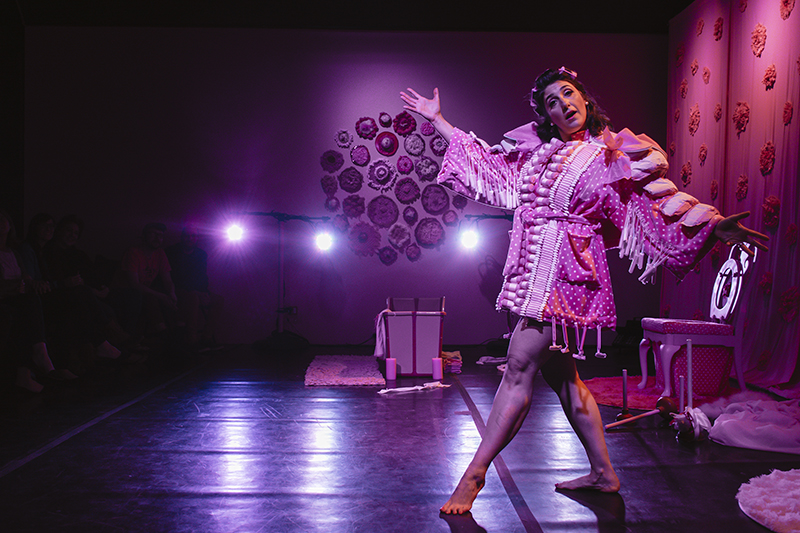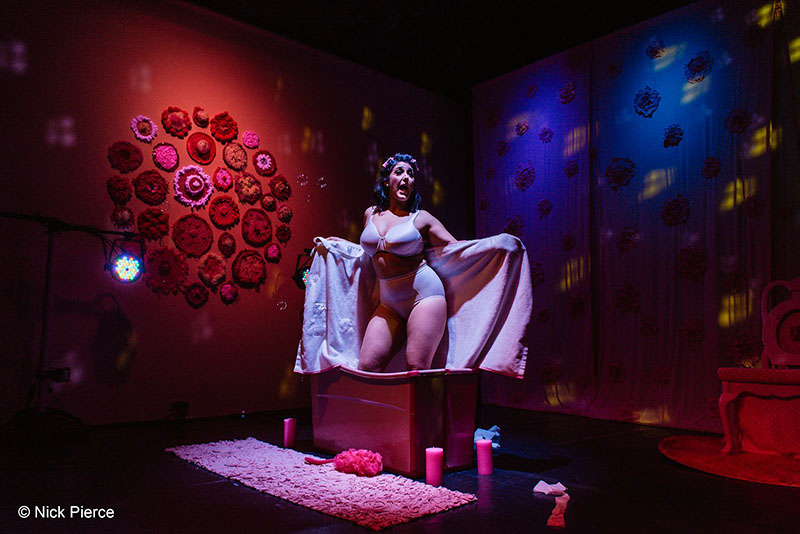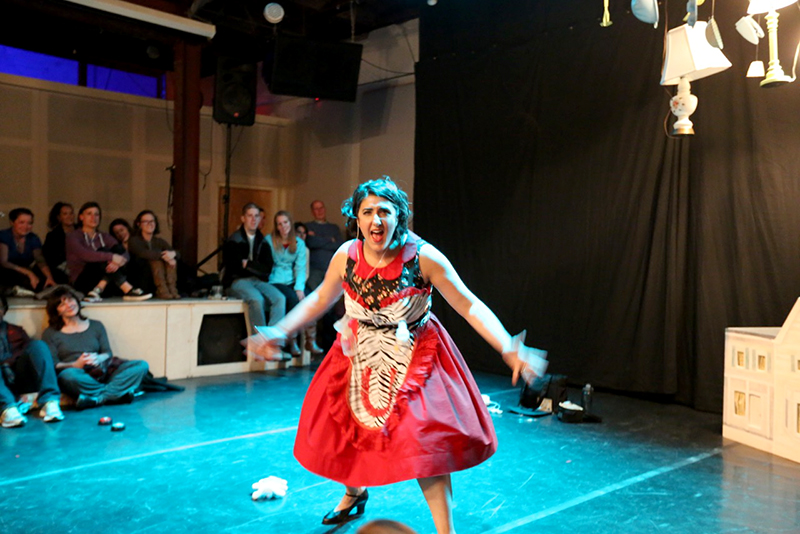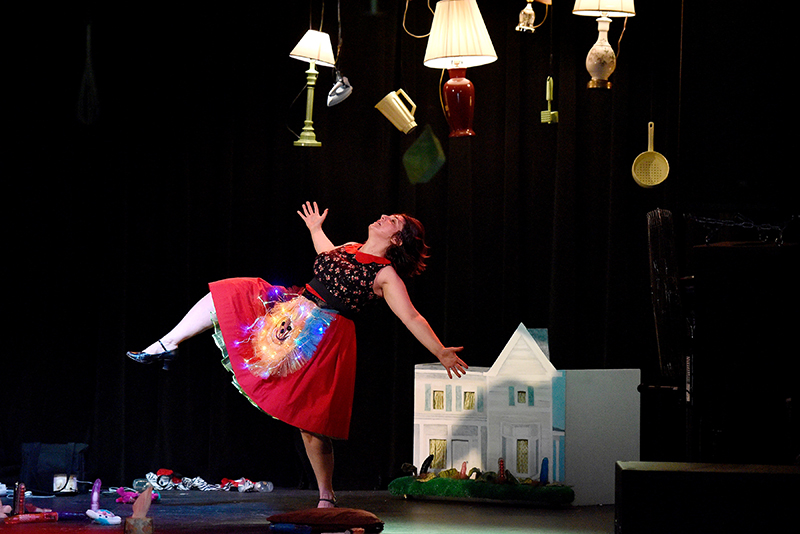Bringing the Private into the Public
An Interview with Sara Juli
BY EMMALY WIEDERHOLT
Sara Juli is a comedic performance artist based in Maine who creates introspective autobiographical solos about what are often seen as private subjects. Her recent pieces include Tense Vagina: an actual diagnosis and Burnt-Out Wife (the titles say it all). Here, she discusses how she goes about bringing taboo topics into the realm of performance and why it’s important to raise awareness and conversation, as well as how her tours and fundraising consultancy were affected by the pandemic.

Sara Juli in Burnt-Out Wife, Robe by Carol Farrel, Photo by Nick Pierce
~~
Can you tell me a little about your dance history – what kinds of performance practices and in what contexts have shaped who you are today?
I am a dance theater comedic performance artist. My training is in improvisational dance and contemporary dance practices. I was based in New York City for 14 years, during which I was performing professionally. Six and a half years ago, I moved to southern Maine, where I live with my husband and two children. Shockingly, my artistry doesn’t fully pay my bills, so for the past 20 years I’ve worked concurrently in arts administration as a fundraising consultant. My fundraising consultancy is entering its 11th year. I work with individual artists and small to mid-size nonprofits primarily in the performing arts to help them execute fundraising strategies. I am very passionate about bringing money and awareness to the arts world and in particular dance.
How would you generally describe your work to someone unfamiliar with it?
I take very personal topics and I bring them to the public using movement, text, sound, song, audience interaction, and humor. I often get a response after shows along the lines of, “You’ve read my diary.” I have the ability to share personal experiences and use humor as a way to make fun of myself but also to use humor as a portal through which to see something deeper. I use the craft of humor strategically to connect with audiences.
I ask: What is it like for me to live on this planet? If it’s happening to me, I figure there are a few million others who are experiencing something similar at the same time. I call them my healing dances. They are relevant and tangible works of art about an hour long with no intermissions. They are about connecting to audiences through the sharing of those personal topics.
In my 20s, one of the topics was reconciling my promiscuous past. That was called How to Forgive Yourself in Bed. Then I made a piece about my family. A large portion of my family perished in the Holocaust and it’s a big part of my family’s history. I fell in love and have since married and had children with someone who is not Jewish. I made a piece called Burden about reconciling my religion with my love. I also made a piece reassessing my relationship to money called The Money Conversation. That was in 2007 and it was my big breakout piece that put me on the map as a touring artist.
What does your process generally look like?
I usually wait for a topic to come to me, which can be mildly slow but organic. I ask: What is bothering me? What’s going on? That can take a while to germinate and fester. What is coming up for me that is a trigger and I need to make a piece of art about it so I can move past it? That’s why I call it them my healing dances because the process of performing the topic over and over again becomes cathartic.
Once an idea comes to me, I journal about that topic. I make notes and talk about it at length before I even set foot in the studio. It often takes me two to three years from beginning to end. I have made 14 evening-length works. Each one is like a baby, and I try to tour them for a couple years minus a pandemic.
I’ve been in and out of therapy my whole life for various traumas that sometimes make their way into my dances, and sometimes don’t. I’ve been thinking recently how oftentimes my work with therapists becomes a trigger point for a dance insofar as them unwrapping something for me that I didn’t see and wanting to share that realization for others, knowing that blockage might exist for others as well. I’m still working on some language about how an abstract voice comes out of therapy work.
My piece Burnt-Out Wife came out of marriage counseling with my husband. The counselor at one point said, “Chris, it sounds like your wife is burnt out.” And I stopped the session and said, “Oh my god, that’s the title!” I’ve been thinking about the language of how I actualize the therapy world and my process. What does it mean to be watching this abstract piece and watching me bring the private to the public?
I like to create a structured score for my work. The score has a tremendous amount of freedom within it. I know I want to get from point A to point B within a scene, but I improvise how I get there. The hour is set in that there are certain points I need to arrive at; however, the timing is fluid and how I arrive is improvised.
Burnt-Out Wife was the first time I worked with a dramaturg. It was also the first time I embarked on a large team project. I’ve always worked with a lighting designer, but now I have a strong artistic team all based in Maine. My lighting designer is Justin Moriarty, my dramaturg is Michelle Mola, my costume designer is Carol Farrell, and my set designer is Pamela Moulton. Burnt-Out Wife was the first piece that I asked for a deep amount of outside help. Working with a dramaturg helped me transform the piece and dig deeper. Moving forward, my process has shifted insofar as I can’t imagine not working with a dramaturg.

Sara Juli in Burnt-Out Wife, Photo by Nick Pierce
I’d like to specifically learn more about your pieces Burnt-Out Wife and Tense Vagina: an actual diagnosis. Can you share more about why you made those pieces?
Tense Vagina came out of my baby-making years, which for me ended up being a five-year period when I had two children two and a half years apart. While culturally and familywise that was a beautiful time, the emotional isolation as well as the postpartum depression was a harsh trigger that I knew I needed to make a piece about. I did not feel good. Tense Vagina is about postpartum depression and the underbelly of motherhood. There’s obviously a stigma around talking about the ugly side of motherhood. I find there’s a particular loneliness that I wanted to explore, as well as to shed some light on pelvic floor rehab.
I gave birth to two children naturally and lost strength in my pelvic floor and, like millions of women, peed my pants for many years after giving birth. I was ashamed and embarrassed until I finally got so fed-up years later and mentioned something to my OBGYN, who said, “Just go to pelvic floor rehab.” I went to the Pelvic Floor Rehab Center of New England and got this treatment that was so awkward and odd and empowering and corrective (in that I no longer peed my pants), that I couldn’t believe no one had offered this information to me earlier. In France, it’s part of the birth package. Women should go right into pelvic floor rehab after giving birth. It’s a muscle and can be built back. We’re expected to turn our attention to the baby and stick in a maxi pad. I was floored that I stumbled upon it when I finally got to a place where I had to say something.
I just wanted to raise awareness that pelvic floor rehab existed; it’s physical therapy for the vagina. Tense Vagina vacillates between exploring the underbelly of motherhood with monologues inserted into the piece where I explore the actual pelvic floor rehab I received. I use humor to poke fun of the rehab and to make a point that there’s nothing to be nervous about.
I knew I wanted to have the word “vagina” in the title because part of the concept is demystifying the word much less the body part. It did prove to be a bold choice. As I toured the piece around the country, some presenters said, “I like the concept, but my audiences aren’t going to go for something with the word ‘vagina’ in it.” I’m very proud of Tense Vagina and I ended up touring it for several years and took it to the Edinburgh Fringe Festival.
It tends to be for female identifying audiences. I’m really proud of getting a group of women together and sharing in the glory of our vaginas. One audience was 80 to 90 percent gay. We had a post-performance discussion afterward that turned into an amazing and caring conversation around the taboo of vaginas. It was a magical evening.

Sara Juli in Tense Vagina, Photo by Alban Maino
Burnt Out Wife came from being challenged by my marriage. It’s common for marriages to hit that mid-stride malaise where the daily routine and intimacy have no fairy tale in sight. I wanted to look at the myth of the romance and magic of love, and to publicly share my marriage counseling experience as a way to shine a light on that. What’s significant is it’s the first piece I put standup comedy in. There’s a 15-minute standup set that sits right in the piece. I wondered: Could I fuse standup with movement and text? I think it worked, but it’s new territory. It’s also the first piece where I created an immersive set; the piece takes place in a Pepto-Bismol pink bathroom. My costumer designer created eight unique costumes including a robe made entirely of feminine hygiene products. It’s amazing and belongs in a museum. Between lighting design, dramaturg, set, and costumes, it was my biggest production to date and provided nice growth for me as an artist.
What is your kid’s relationship to your performance practice?
I try to be very communicative with my children about my work. I’m a performer through and through; I’ll perform while cooking dinner, or we’ll do impromptu dances in the living room. However, I haven’t made a show that’s appropriate for children, nor have my kids been to my live performances. Tense Vagina had a dildo garden since dildos are part of pelvic floor rehab. I turn about 40 of them on and I danced to the vibrations. Do they need to know what a dildo is? They do not.
What I do is I put on a special show for them. For Burnt-Out Wife, I invited them to come to the stage and did a mini show that skipped the inappropriate parts. Of the hour show, I think there were 15 minutes that were kid friendly. I performed full out for them for 15 minutes, and they said, “Mommy, that’s great but all these people are going to come and it’s really short.” So they certainly have seen me in action, but in a suitable-for-kids version.
You run a fundraising consulting business as well. How has your consultation practice adapted to the conditions of the pandemic? What trends are you seeing?
It’s all over the place. People are trying to figure things out. There are plenty of people who did not get hit hard, and there is even a subset of people who have been able to make money during this time. There are still people who have plenty of means and who have been generous. In some regards, nonprofits have seen an uptick in individual donations, and in other situations, annual donors have needed to reduce or discontinue their donations. It leveled out in that some people could give more, others could give less. I lost clients who said they couldn’t afford a consultant, and then some brand new clients came to me.
A lot of nonprofits are just treading water trying to buy time. There have been a lot of furloughs. The arts industry is taking a real hit. It’s been challenging for me as a consultant. It’s too soon to make any over-arching assessments. Money is still very much needed. It’s going to take a long time to build the arts industry back up once this pandemic is behind us.
What’s your next project or focus?
I spent two years building Burnt-Out Wife and received National Dance Project funding from the New England Foundation for the Arts last year, and it manifested in quite a large national tour in 2020 that was promptly cancelled. It took me several years to build that up, and three days in March to come crashing down. I have been mourning that loss. I feel blessed that I got to perform it a few times, but for the financial and emotional investment, it’s gone.
I recently finished a weeklong virtual residency at Redfern Arts Center at Keene State College, which was brand new for me. They showed the recording of Burnt-Out Wife, which we’re calling the virtual edition. It was recorded with a two-camera shoot. If I had known there would be a pandemic and this is how I would market my work, I would have invested more in video documentation, but this is the product I have to sell right now. And then I’ve been doing some panels and roundtable discussions, as well as some teaching. I’m working on giving Burnt-Out Wife a little more of a life.
There will eventually be another piece. I just don’t know where or when.
Any other thoughts?
In August, I did my first virtual performance of Burnt-Out Wife at American Dance Festival. I’m an ADF alumni and they’ve been a huge supporter of my work over my 20-year career. I want to give them recognition for how they’ve taken me under their wing and supported me.

Sara Juli in Tense Vagina, Photo by Grant Halverson, Copyright ADF
~~
To learn more, visit www.sarajuli.com.
A virtual performance of Burnt-Out Wife is available April 8-11 through Catamount Arts. More information is available here: https://www.catamountarts.org/show/details/burnt-out-wife/

2 Responses to “Bringing the Private into the Public”
Thanks Kayla!
This is awesome! Love it.
Comments are closed.